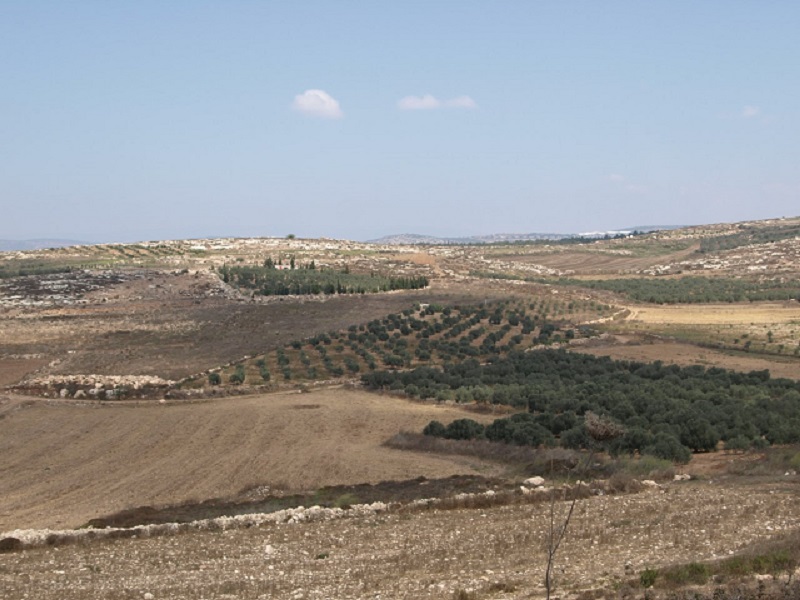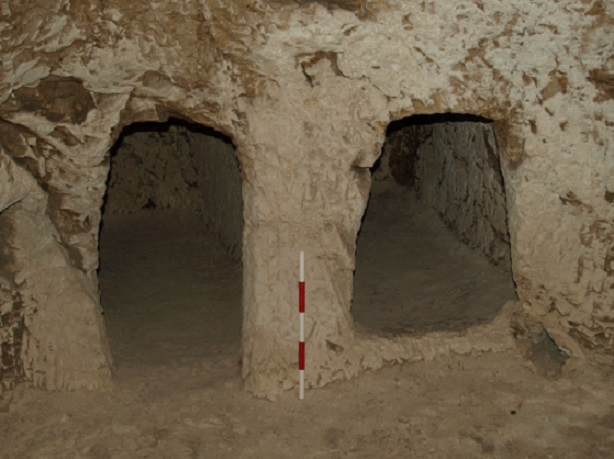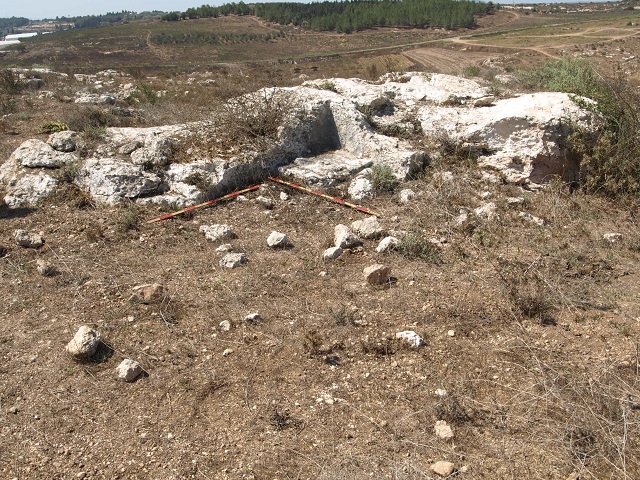The combined evidence of these three sites indicates that Nazareth was inhabited from at least the early first century, and probably the Late Hellenistic period onward, as a Jewish community, including family groups, judging from the finds and house plans.
See Also: Roman-Period and Byzantine Nazareth and its Hinterland (Routledge, 2020).
By Ken Dark
Professor, University of Reading
July 2020
Until recently, professional archaeologists had largely neglected Nazareth in Galilee. Most of what was known about the settlement prior to the turn of this millennium consisted of evidence found during the construction of the present-day Church of the Annunciation (the cathedral-sized church in central Nazareth) and a series of rock-cut tombs discovered predominantly in the nineteenth century. It is often assumed that the tombs date from the period of the Gospels and indicate the extent of the first-century settlement. However, the majority of the tombs can neither be closely dated, nor can it be taken for granted that plotting their distribution enables the identification of the limits of the occupied area. Rock-cut tombs are especially hard to date accurately because they were made to be accessed over a long period of time so human bones and manufactured objects could be added and removed from them. As they were excavated before the use of modern methods, this means that the only way to date the Nazareth tombs is by comparing their constructional details with well-dated examples from elsewhere.

Fortunately, Israeli archaeologists working in the Jerusalem and Jericho areas, and in Galilee itself, have established a well-dated sequence of tomb types. When applied to Nazareth this demonstrates the close similarities between the Nazareth tombs and those in these areas. However, some features are more common in Galilee than farther south. For example, tombs sealed with disc-shaped stones (“rolling stones”) are more often found and used for a more extensive social range in Lower Galilee – including the excavated cemetery at Migdal Ha-’Emeq southwest of Nazareth – than in the Jerusalem area. Nevertheless, when applied critically, this method enables a broad chronology to be established for the Nazareth tombs. The earliest found so far date to the first century but there is no reason to assign any of them to the first half of that century. Consequently, they offer no evidence for the character or extent of the early first-century settlement there.
While all the known tombs might postdate the first half of the first century, nonetheless archaeological evidence for early first-century occupation in Nazareth does exist. At the Church of the Annunciation, re-evaluating the long series of excavations undertaken by Franciscan scholars has greatly clarified both the dating and interpretation of the excavated features. The numerous artificial underground spaces found below Late Roman and Byzantine structures can be divided into three sub-phases, identifiable because the construction of some of these features involved cutting through others. On this basis, the earliest features were rock-cut pits for the storage of crops (silos), cisterns for water storage, and installations for the production of wine and olive oil. Bellarmino Bagatti, the director of the Church of the Annunciation excavation, correctly identified these, and the work of Joan Taylor subsequently clarified their interpretation. However, it was previously unrecognized that these features were cut into by narrow burrow-like tunnels characteristic of hiding places from the period of the Jewish Revolts – here probably the First Revolt specifically. Later, large cisterns were built, possibly to serve the needs of more than a single household, suggesting continued occupation after the Revolt. Pottery from the site is consistent with activity between the early first century and the fourth century when the earliest church was built at the site. This substantiates the interpretation, proposed by Bagatti, that the Church of the Annunciation site was within an early first- to fourth-century settlement. The presence of limestone vessel fragments of the type characteristic of the Early Roman-period Jewish communities in Galilee suggests that this settlement was culturally Jewish.
Corroborating evidence comes from two adjacent sites. At the International Marian Center (IMC) site across the modern street from the present Church of the Annunciation complex, an Israel Antiquities Authority rescue excavation directed by Yardenna Alexandre identified a surface-built domestic structure occupied from the Late Hellenistic period until the late second century, associated with limestone vessel fragments among other objects. Consisting of rectilinear rooms with an adjacent courtyard area, this structure may be described as a courtyard house; its design suggests use by an extended family. As at the Church of the Annunciation site, storage pits under the house were reused as hiding places during the First Revolt. Occupation continued afterward, albeit for a shorter period of time.
The other site, which I hope to discuss in more detail in another article here later this year, is also very close to the Church of the Annunciation, at the Sisters of Nazareth convent. The earliest archaeological discoveries were made at the convent in the 1880s, but despite over 80 years of subsequent excavation, the site was almost entirely unpublished until 2006 when the Nazareth Archaeological Project re-examined it. There are several first-century phases of activity at the Sisters of Nazareth convent. In the first, a partly rock-cut structure, perhaps another courtyard house, was occupied by people using a similar material culture to those at the IMC site, again indicating Jewish domestic use. Unlike the IMC house, that at the Sisters of Nazareth was disused and the site given over to small-scale quarrying before being cut into for at least one and probably two rock-cut tombs. As one of these is very well preserved and typologically dated to no later than c.100, the whole sequence from house to quarry to cemetery probably lasted less than a century. The establishment of a cemetery at a place previously used for a house is unusual in a Jewish context, although part of the Church of the Annunciation site was also used for a rock-cut tomb probably built before the second century. At the Sisters of Nazareth, the intervening episode of quarrying may have resulted in the perception when the tombs were constructed that the location was a quarry rather than a house.

The combined evidence of these three sites indicates that Nazareth was inhabited from at least the early first century, and probably the Late Hellenistic period onward, as a Jewish community, including family groups, judging from the finds and house plans. Other excavated evidence from Nazareth support this impression, including pottery and agricultural activities at the well-known Nazareth Village (or Nazareth Village Farm) site and the less widely known but equally archaeologically interesting Israel Antiquities Authority rescue excavation at Wadi el-Juani. Several sites in and very close to modern Nazareth have also produced evidence of quarrying, apparently for building stone, suggesting that quarrying was an important activity in the settlement’s otherwise agricultural Roman-period economy. Other craft activities are evident: weaving at the Sisters of Nazareth and IMC sites and possible hints of glass-working at or near both sites.

This new picture of first-century Nazareth is put into context by archaeological research in the valley between Nazareth and the Roman town of Sepphoris to its north. Combining evidence from fieldwalking (systemically recording artifacts turned up by plowing) and surface survey by the Nazareth Archaeological Project and Israel Antiquities Authority rescue excavations, it is possible to identify an Early Roman-period settlement pattern comprising farms and villages of varying sizes. Like Nazareth, several of these settlements show evidence of craft-working activity and especially quarrying. A distinctive pattern exists in terms of the objects people used and how they disposed of them when they were broken. Settlements nearer Sepphoris had a wider range of objects and were surrounded by thin scatters of broken objects, mostly pottery and glass, whereas a much more restricted range of objects and no similar scatters of material are present at those nearer Nazareth. Thin scatters of material such as those surrounding the settlements near Sepphoris have been interpreted by archaeologists working across the Roman world as the spreading of domestic waste on fields, suggesting that this practice was acceptable to those living near Sepphoris but eschewed by those living near Nazareth. It is also noticeable that the range of objects found in and near Nazareth includes nothing made by anyone other than Jews, unlike the objects found near Sepphoris. Together, this evidence suggests that cultural attitudes in Nazareth were different from those in Sepphoris, although the presence of limestone vessels on sites across the valley suggests that the valley had a Jewish population. Consequently, the most plausible explanation of this pattern is that the inhabitants of Sepphoris and its surrounding settlements followed a less strict version of Judaism, and one more open to Roman provincial culture, than those of Nazareth. This is also evident when comparing archaeological evidence from Sepphoris and Nazareth, as demonstrated by the sites already discussed.
All of this tells us quite a lot about early first-century Nazareth. The settlement clearly did exist in the early first century, contrary to some recent ill-informed speculations, and was an agricultural community with a population following a strict interpretation of Second Temple Judaism. The settlement is associated with quarrying, as were those in the valley between it and Sepphoris, and the number of quarries close to Nazareth suggests that quarrying might have been an unusually important characteristic of the local economy. This would hardly be surprising since the limestone of the area is relatively easy to quarry and shape, yet durable enough for construction and the manufacture of limestone vessels. Hints of glass-working and evidence for cloth production show that other crafts probably also took place. Nazareth may have provided both goods and services – such as crop processing – for smaller communities living in the valley immediately to its north.
Reinterpreting the archaeology of early first-century Nazareth also has many implications for interpreting the Gospels. For example, in view of the exclusively Jewish character of Early Roman-period Nazareth and its immediate adjacent landscape, it is extremely unlikely that Jesus was influenced by Classical philosophy, making the “Cynic Jesus” hypothesis untenable. Nor does it support the suggestion of a Roman military presence in or close to Nazareth during the early first century.
In general, archaeological evidence for the early first-century settlement contains nothing inconsistent with the presentation of Nazareth in the Gospels. If Nazareth were a Jewish village functioning as a center for surrounding agricultural communities and associated with craft-working and quarrying, then this was exactly the sort of place where one might expect there to be a synagogue, whether as a building or public assembly, like that mentioned in the Gospels of Matthew and Mark, and where one might find a τέκτων (tekton), a craftsman, a term used for Jesus and Joseph in the same Gospels.
Note: This article outlines some of the interpretations proposed and discussed in much more detail in K. Dark (2020) Roman-Period and Byzantine Nazareth and Its Hinterland (London: Routledge).
Article Comments
But it is not only the…
But it is not only the citizens of Nazareth who reject him but his own family (Mark 6:4). His friends concluded he was "beside himself" (3:21), and when they failed to deter him his family intervened (3:31), just as Joan of Arc's family reacted when she uncharacteristically left home. They seem to have known nothing of shepherds, stars or magi, or even of miracles -- 6:5 contradicts 6:2. Familiarity breeds contempt among the just and the unjust. --AGF
6:5 does not contradict 6:2…
6:5 does not contradict 6:2. These are different points of view - In 6:2 the deprecating villagers are amazed by the healings calling them mighty works, perhaps in comparison to no works previously done at all, but Mark knew the rest of Jesus' miracles and by comparison to the few healings, recognized that no truly mighty works were done there.
I just want to say that I am…
I just want to say that I am very grateful that these comments are available. 2 years, and a year have passed since these comments were posted, but I just recently stumbled upon this site and have had so much joy and indeed inspiration in reading the comments. They really add to the article.
Fascinating what people will…
Fascinating what people will read into archaeology. Christians, try to read history and archaeology, not Christian doctrine, as you attempt to decipher scholarship-based articles like this one.
What this piece indicates is that there was a clear split between the Hellenized Jews who lived in Sepphoris (possibly, among Romans and other non-Jews) and the less- or non-Hellenized Jews who lived in and around Nazareth (who were not "Nazarethians," but Nazarenes). The Galilee was one of the centers of the Jewish Revolt of 66-70 CE; in the revolt, the more cosmopolitan Jews of the cities were generally disinterested in fighting against the Romans, who had inherited the "civilized" culture of the Greeks (thus, "Greco-Roman" culture). This, btw, echoed the similar conflict between Hellenized and non-Hellenized Jews during the Maccabean revolts of the 160s-130s BCE, a fight that began in the Galilee.
What this article tells us is that Jesus, assuming he existed and was related to the Jesus of the Christian texts, was from the more conservative Jewish town, and the teachings that are most likely to be genuine reflect an emphasis on returning Hellenized Jews to the fold of the "law and the prophets" -- that is, Torah observance as it existed during that time, and supplemental readings from the prophets. Jesus is quoted many times as saying that his mission was toward "the lost sheep of the house of Israel" -- many of whom lived less than 6 km from his home, in Sepphoris.
As for the so-called Cynic Jesus, as well as for the Buddhist Jesus: as put in the comment above, this is sheer speculation, and highly unlikely. If Jesus "disappeared," there's no indication of it except for times when he would have gone into the desert to engage in contemplation. The article supports the notion that although Jesus probably knew some Greek phrases, he was most likely an Aramaic speaker who could read the traditional Hebrew texts and prayers, and comment on them (Hebrew was already reserved strictly for study and prayer by Jesus' time). This puts the notion of a Cynic Jesus to rest.
Moreover, it's unlikely that Jesus and Joseph were carpenters in the way they're usually depicted. The word used to describe them in the NT Greek means "craftsperson," and the presence of the quarries, along with the lack of forests in the area, suggest that they were stone crafters, rather than wood carpenters. They may even have helped build the city of Sepphoris.
But is it not unlikely that…
But is it not unlikely that in the same place as a cemetery, it is forbidden to have a settlement there according the Jews law, so no Nazareth there in the first century!!!!

I’m not particularly persuaded by the Cynic Jesus theory but if I thought that Jesus was a Cynic or a Buddhist I would not be too discouraged by the evidence here. If it is true that Jesus was tethrammenos in this place, which was a place of plain, strict rural Judaism, if that’s a fair term, then we can conclude that the influences on him in childhood and first youth did not, to all appearances, include any other than Judaism. But the Jesus presented to us in the days of his ministry was past first youth and it is a natural reading of the reports to think that he had been away for a while. The portrait of the Nazarethians is rather negative: they do not honour Jesus, they cannot imagine that one of their own is really outstanding, they will not react reasonably to the evidence of their eyes, they are a little thuggish. So we are being told, rightly or wrongly, that Jesus was not quite what they were. The nature and degree of his difference from them or evolution away from them remains to be determined but it is a different which the accounts of Jesus’ life ask us to note. The detail in John, that Nathanael, the type of those guileless people who were Israelites indeed, has problems about Nazareth is a bit tantalising.